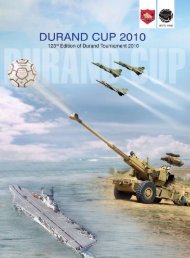Shimla-the birthplace of the Durand Cup and the Indian Air Force ...
Shimla-the birthplace of the Durand Cup and the Indian Air Force ...
Shimla-the birthplace of the Durand Cup and the Indian Air Force ...
You also want an ePaper? Increase the reach of your titles
YUMPU automatically turns print PDFs into web optimized ePapers that Google loves.
as one <strong>of</strong> <strong>the</strong> finalists for regimental army teams. Regimental<br />
teams nowadays play before a few hundred spectators as <strong>the</strong>y<br />
no longer have <strong>the</strong> charisma or talented players, for spectators<br />
to flock to <strong>the</strong> Ambedkar stadium to see <strong>the</strong>m in action. This<br />
decline is both sad <strong>and</strong> baffling but is an apt reflection <strong>of</strong><br />
changing values in society <strong>and</strong> receding interest in regimental<br />
sports. It seems like an age gone by, but in <strong>the</strong> 1966 <strong>Dur<strong>and</strong></strong><br />
tournament, three <strong>of</strong> <strong>the</strong> semi-finalists were regimental teams<br />
from <strong>the</strong> Services, <strong>the</strong> ultimate winners Gorkha Briagde,<br />
runners-up Sikh Regimental Centre (SRC) from Meerut <strong>and</strong><br />
EME Secunderabad. Mohun Bagan was <strong>the</strong> only civilian side<br />
in <strong>the</strong> last four <strong>of</strong> <strong>the</strong> tournament. The 950s <strong>and</strong> 1960s were<br />
<strong>the</strong> heydays <strong>of</strong> regimental teams in <strong>the</strong> <strong>Dur<strong>and</strong></strong> tournament. In<br />
1965, <strong>the</strong> newly formed Delhi Garrison, formed after <strong>the</strong> 1965<br />
Indo-Pak conflict was <strong>the</strong> cynosure <strong>of</strong> all attention. This crack<br />
regimental team, with stalwarts like Bhupender Singh Rawat,<br />
K.B. Sharma <strong>and</strong> Amar bahadur upfront <strong>and</strong> Khairuddin <strong>and</strong><br />
Mahadevan in defence <strong>and</strong> Arvinder Singh as goalkeeper<br />
delighted <strong>the</strong> crowds with <strong>the</strong>ir attacking, spirited football.<br />
They upset mighty East Bengal, which included stalwarts like<br />
Peter Thangaraj, Sukumar Samajpati, Parimal Dey, Sushil<br />
Sinha <strong>and</strong> P. Sinha in <strong>the</strong>ir ranks, 1 -0 in <strong>the</strong> quarterfinals. In<br />
<strong>the</strong> semi-finals Punjab Police upset <strong>the</strong>m.<br />
MRC Wellington was a name to conjure with in <strong>the</strong> <strong>Dur<strong>and</strong></strong><br />
tournament. In <strong>the</strong> 1950s <strong>and</strong> early 1960s <strong>the</strong>y were a wellknit<br />
team <strong>of</strong> <strong>the</strong> most successful <strong>and</strong> best goalkeepers India<br />
has produced. He was involved in both <strong>the</strong>ir <strong>Dur<strong>and</strong></strong> triumphs<br />
<strong>of</strong> 1955 <strong>and</strong> 1958 <strong>and</strong> left for Mohammedan Sporting, Calcutta<br />
only in 1961, after having played in two Olympics, Asian Games<br />
<strong>and</strong> Asia <strong>Cup</strong>. Inside forward Kuppaswamy <strong>and</strong> right winger<br />
Kamachi, D’Cruz, Alfonso <strong>and</strong> Mukundan were some <strong>of</strong> <strong>the</strong><br />
o<strong>the</strong>r great players who made MRC a formidable team some<br />
four decades ago. In <strong>the</strong> 1958 <strong>Dur<strong>and</strong></strong> semi finaIs, <strong>the</strong>y upset<br />
a formidable East Bengal 2-1. East Bengal had players like<br />
goalkeeper Sanat Sett, defender Byomkesh Bose, midfielders<br />
Anil Gupta, Ram Bahadur <strong>and</strong> Bir Bahadur <strong>and</strong> forwards<br />
Moosa, Tulsidas Balaram <strong>and</strong> Dhanraj in <strong>the</strong>ir ranks. In 1956<br />
MRC also reached <strong>the</strong> <strong>Dur<strong>and</strong></strong> semi-finals <strong>and</strong> , played an epic<br />
encounter with mighty East Bengal. Twice <strong>the</strong> match ended<br />
in goalless draws but on <strong>the</strong> third day, East Bengal prevailed<br />
2-0 with <strong>the</strong> astute Kanaiyan scoring <strong>the</strong> opening goal. In<br />
<strong>the</strong> 1950s, MRC had a lot <strong>of</strong> support from <strong>the</strong>ir comm<strong>and</strong>ing<br />
<strong>of</strong>ficer, who invariably came to witness <strong>the</strong>ir important<br />
matches <strong>and</strong> arranged to send <strong>the</strong>m to Delhi well in advance<br />
to get acclimatised. Besides <strong>the</strong> <strong>Dur<strong>and</strong></strong> <strong>the</strong>y also won <strong>the</strong> DCM<br />
tournament in 1962 <strong>and</strong> were runners up in 1961.<br />
EME Secunderabad, never won <strong>the</strong> <strong>Dur<strong>and</strong></strong> tournament but<br />
emerged champions <strong>of</strong> <strong>the</strong> Rovers <strong>Cup</strong> in 1961 when <strong>the</strong>y upset<br />
Mohun Bagan 1-0, which included legends like Chuni Goswami,<br />
28 July 2011 purple beret<br />
Arumainayagam, Jarnail Singh, Sanat Sett <strong>and</strong> T.A. Rehman in<br />
<strong>the</strong>ir ranks. In that same year EME reached <strong>the</strong> <strong>Dur<strong>and</strong></strong> semifinals<br />
but lost 0-2 to Mohun Bagan with goals by Dipu Das<br />
<strong>and</strong> Salauddin. EME also upset East Bengal 1 -0 in <strong>the</strong> quarter<br />
finals in 1966 with left striker Jayaraman scoring a memorable<br />
top <strong>of</strong> <strong>the</strong> box left-footed volley. EME Secunderabad, emerged<br />
champions <strong>of</strong> <strong>the</strong> DCM tournament in 1963 beating Punjab<br />
Police 3-1 in <strong>the</strong> replay after <strong>the</strong> first match ended in a goalless<br />
draw. Bir Bahadur, international defender Tarlok Singh <strong>and</strong><br />
Khairuddin were some <strong>of</strong> <strong>the</strong> notable players who donned <strong>the</strong><br />
colours <strong>of</strong> EME.<br />
MEG Bangalore never reached a <strong>Dur<strong>and</strong></strong> final but was always a<br />
force to reckon with. They produced some outst<strong>and</strong>ing players,<br />
skillful playmaker Ethiraj, goalkeeper K. Sampath <strong>and</strong> solid<br />
defender K. Madhavan. In <strong>the</strong> 1967 <strong>Dur<strong>and</strong></strong> pre-quarter finals<br />
<strong>the</strong>y played draws with mighty Andhra Pradesh Police for two<br />
successive days. In <strong>the</strong> second replay <strong>the</strong>y led 2-0 at half-time<br />
but inspired by majestic Yusuf Khan, Andhra Pradesh Police<br />
rallied to win 3-2. ASC Centre (South) Bang produced two very<br />
skillful players in <strong>the</strong> seventies, Aziz, who later played for<br />
Mohammedan Sporting <strong>and</strong> Shankaran Kutty. BEG Roorkee<br />
<strong>and</strong> AOC Secunderabad were o<strong>the</strong>r formidable regimental<br />
teams capable <strong>of</strong> troubling <strong>the</strong> best in <strong>the</strong> l<strong>and</strong>.<br />
IAF also produced some notable players, dashing winger<br />
Subir Sarkar who later played for Bengal <strong>and</strong> Mohammedan<br />
Sporting, <strong>the</strong> tall striker Biswas, midfielder Paul Raj, <strong>the</strong><br />
elusive Ramch<strong>and</strong>ran, Mat<strong>the</strong>ws, Kanaran, Balakrishnan <strong>and</strong><br />
several o<strong>the</strong>rs. They troubled <strong>the</strong> best teams in <strong>the</strong> country by<br />
<strong>the</strong>ir spirited displays <strong>and</strong> regularly reached <strong>the</strong> quarter-final<br />
stage <strong>of</strong> <strong>the</strong> tournament. India Navy also reached <strong>the</strong> <strong>Dur<strong>and</strong></strong><br />
quarterfinals regularly <strong>and</strong> were feared opponents.<br />
Support from <strong>the</strong> <strong>of</strong>ficer class, which is now declining,<br />
regimental pride <strong>and</strong> more emphasis on sports were <strong>the</strong> factors<br />
which led to <strong>the</strong> success <strong>of</strong> <strong>the</strong> Regimental teams in <strong>the</strong> past.<br />
It was a different ethos in <strong>the</strong> 1950s which produced so many<br />
fine Regimental football teams. Now with warfare becoming<br />
more technological, <strong>the</strong> same importance is not being given to<br />
football <strong>and</strong> sports in <strong>the</strong> Services.



